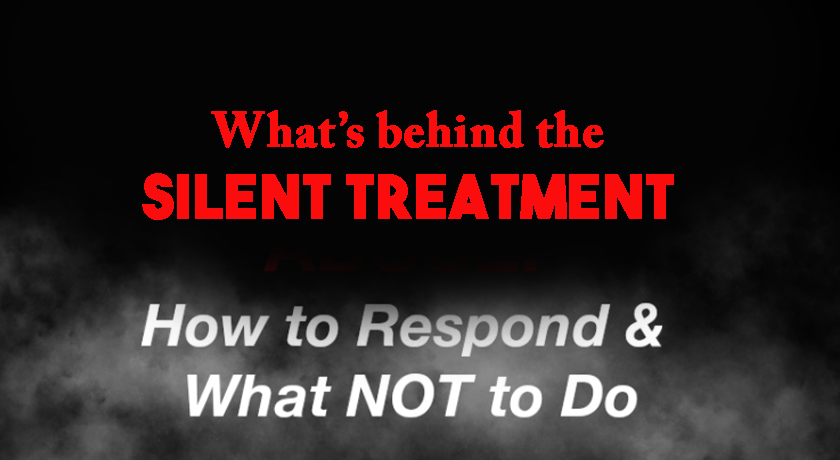UPDATE 01/26/2023:
The silent treatment is a behavior employed by narcissists, to try and cause anxiety and obsession in another person. The original article detailed steps to take when one finds themself as the target of the silent treatment. This addition will analyze why narcissists use the silent treatment, in the first place.
The motivation behind the silent treatment is a lack of control over another person. By creating a scenario where the other person has to chase after the cause of the silence and mollify it, the narcissist absolves themself of having to clearly communicate their feelings, while also creating the assumption of fault in the other.
From a non-clinical perspective, there are three grades of silent treatment.
First: The person is silent, because they are unable to articulate their issue or are facing a total lack of control over their environment. The silence will come suddenly, leaving the other person questioning the reason. The more the other person questions the narcissist–and the less equipped the narcissist is to discuss what is actually wrong–the more tension will build on both sides, leading to an eventual outburst. Well-intentioned questions and needling behavior serves to remind the narcissist that something is wrong. Eventually, the feelings the narcissist was having about the outside issue will be transferred to the person trying to help, therefore lengthening the duration of the cycle.
Second: The person is silent, because something you have done has bothered them. The silence is then hypocritical; here, the narcissist places the onus on the other person to “sort out” the unnamed transgression. In fact, there may not even be a transgression! The point of the silence is to keep the other person absorbed with managing the narcissists emotions and reactions.
Third: The last type of silent treatment is the most obviously sinister. They are silent because of your failure and they want you to know it. The point of this behavior is to punish. The only way to end this kind of silence is to relinquish an element of control or to bend to the narcissist’s will.
Though, typically abusive silence is stereotyped as the Third type, all variations of silent treatment are emotional abuse. Emotionally mature adults are required to communicate their emotions in a constructive and non-combative way. Do not ignore these signs and symptoms of a greater issue in a relationship.
Most importantly, do not take blame when faced with this behavior.
ORIGINAL ARTICLE:
Calls going straight to voicemail? Repeating conversations in your head and wondering where you went wrong? Can’t understand why you have so much to say and they don’t even have one word? Silent treatment is a form of emotional abuse. It’s a control tactic used to confuse the victim and cause anxiety. It is a form of manipulation and it hurts to be on the receiving end. So what is considered “silent treatment” and how should you respond?
What is “The Silent Treatment”?
Carmen Sakurai, Certified Life Strategist and Advocate for Victims of NPD Abuse, claims that all of the following are considered silent treatment:
- Refusing to speak to you.
- Not acknowledging what you say.
- Ignoring phone calls, text messages, etc.
- Pretending not to hear you.
- Avoiding your company.
- Not acknowledging your feelings and opinions.
- Dropping off the radar for a length of time, then reappear, acting as though nothing happened and everything has always been fine.
- Ignoring your needs and requests to communicate clearly.
- Behavior intended to make them feel invisible or invalid.
The Reasons Behind Silent Treatment
Sakurai collected the most common reasons from clients, support group members, and online surveys, to why people choose to go silent. These include:
- They have been victims of emotional abuse themselves and see silent treatment as revenge.
- They are narcissistic by nature.
- They are not good at expressing themselves.
- To punish the other person.
- To control the other person / manipulate the situation.
- To inflict emotional pain.
- They feel they weren’t taken seriously, so communication just seems pointless.
- Feeling too overwhelmed to talk about or deal with the issue.
- Afraid of their temper.
- Afraid of how the other person will react to what they have to say.
- Hoping time will make the problem go away.
- To inflict the pain they were put through.
How to Respond
The Gentle Approach
This approach is best used towards the person who doesn’t do this regularly. This is usually a sign they are hurting. Timothy J. Legg, Ph.D., suggests that you calmly tell the person that you’ve noticed they’re not responding and you want to understand why.”If they don’t seem receptive, tell them you understand they may need some time alone. But state that you’d like to arrange a time to get together and resolve the problem.”
The Honest Approach
Legg says, “Tell the person how the silent treatment hurts and leaves you feeling frustrated and alone. That’s not what you want or need in a relationship.” You should explain that this isn’t a way to resolve issues and be specific about those issues. If these are deal-breakers for you, then say it.
The “Calm, Cool, and Collected” Approach
The silent treatment isn’t always meant to hurt you. Sometimes, it’s a defensive mechanism or they simply don’t know how to respond yet. While other times it is a passive-aggressive tactic to hold control over you. “In these cases, what they want is for you to feel bad enough to make the first move. They’re biding their time, waiting for you to grovel and give in to demands.” according to Legg.
If you can, go about your business as if it doesn’t bother you. It may be easier said than done, but try to distract yourself the best you can. This way you deprive them of the reaction they seek. Show that the silent treatment is no way to get what they want from you.
The Solution Approach
Legg says, “Suggest a face-to-face meeting to hammer out some rules for better communication in the future. Make a plan for how you’ll talk to each other when things get heated and how you’ll avoid the silent treatment moving forward.” If asking them why they won’t respond and telling them that you’re upset doesn’t seem to be working then try coming up with the next step to resolution.
What Not to Do:
There may not be a perfect solution to the silent treatment. It may get to the point where your relationship has become so emotionally abusive that you need to walk away. Here are some things Legg suggests you DON’T do in retaliation:
- respond in anger, which can just escalate things.
- beg or plead, which only encourages the behavior.
- apologize just to put an end to it, even though you did nothing wrong.
- continuing to try reasoning with the other person after you’ve already given it a shot.
- take it personally, as you’re not to blame for how others choose to treat you.
- threaten to end the relationship unless you’re prepared to do so.
Sources:
https://app.pubninja.com/login-home/login
https://www.healthline.com/health/silent-treatment#signs-of-emotional-abuse
Sources 01/26/2023:
https://psychcentral.com/blog/psychology-self/2020/03/narcissism-silent-treatment#4
themindsjournal.com/truth-about-silent-treatment-wont-say-whats-wrong/



